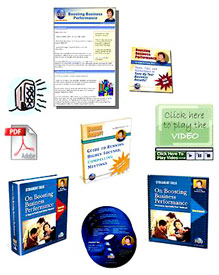“An
Overview of Creating and Marketing Your Own Digital Information Products”
Our
January 30th event attracted a crowd of aspiring information
product producers as well as a variety of skilled people who can help
creators reach their goals.
 This
session was Part 2 of a two-part series covering both
printed and digital products: This
session was Part 2 of a two-part series covering both
printed and digital products:
-
-
In
Part 2, I (Adele Sommers) launched into the world of “info-preneuring”
— the term used to describe the creation of information-based
products that you can produce and market in a variety of ways for
many different purposes. I concentrated primarily on digital
products, which include many things that also can be delivered in
physical form.
- If
you are interested in learning more, please let us know what your
interests are (e-mail Adele@LearnShareProsper.com).
You
Can Watch the Movie...
 I've
recorded the slide show presentation as a set of narrated Flash-based
videos with an accompanying note-taking
guide. I've
recorded the slide show presentation as a set of narrated Flash-based
videos with an accompanying note-taking
guide.
Please
note that the presentation and guide contain details that do not appear
in the highlights below.
The presentation
is divided into short sections for convenient viewing. All videos were
created using Camtasia
Studio.
Click
this link if you want to:
- Watch
an 86-second QuickTime “Sneak Preview”
- Watch
the 43-minute Flash video series
...Or
Read the Highlights:
Here's
a little background information. My personal story — a case
study if you will — started a few years ago. Professionally, I
specialize in human and business performance, which is a superset of
instructional design and technical communication. I had a strong corporate
and academic background with many pockets of valuable knowledge that
just weren’t being used. I had finally reached a point in my career
where I needed to find a way to create, showcase, and disseminate my
knowledge and ideas in the areas about which I was passionate, even
if it meant repackaging it for new audiences.
Eventually,
I stumbled onto a model being used on the Internet that involved something
called “information products.” I immediately began
to study the process in earnest, and then sat down to write a plan of
action. Nearly two years later, I've completed two books and several
other publications, and have launched a Web site at LearnShareProsper.com.
Much like
Lori Rai's Part 1 presentation, I created my own case study that
involved my personal research on what it takes to create and market
digital information products. And although I’m definitely still
on a learning curve, I’ve gotten some positive and sometimes surprising
results from my efforts so far. This event offered a great way to share
my findings and lessons learned to date. Here are the key points
I covered:
Why
is this topic so important?
-
Global
competition, cooperation, and consumption are increasing. This
means we have both new challenges and opportunities arising simultaneously.
-
As
information professionals, we face shifting occupational trends.
For example, in various countries, some information design and software
development work that was once done domestically is now being performed
by professionals elsewhere.
-
Many
people with similar skills compete in a crowded marketplace. Worldwide,
we’ve all seen some challenging times as we adjust to the aftermath
of the dot.com-fueled recession, and other significant world events.
-
Information
products offer new opportunities to spark attention and add value.
This is the main premise I shared during the presentation.
-
You
can use information products to create new audiences for your skills.
I offered a variety of ideas for consideration, and I hope they supply
useful food for thought.
This
presentation addressed 3 important questions:
Question
1: What are information products, and how do we ourselves consume them?
-
Definition:
Here’s a meaning I derived that doesn’t yet appear in
any official dictionary. I like to think of an information product
as:
|
Any
form of knowledge derived from study, experience, or instruction
that is packaged for human consumption.
|
-
Information
products are really a form of self-expression.
They represent a powerful vehicle for sharing anything from a “how-to”
guide to a collection of one’s ideas, philosophy, innovations,
or knowledge. They can be destinations in and of themselves, or part
of the journey toward greater visibility and recognition for an even
broader purpose.
-
Information
products can assume a variety
of forms. 
Examples can include online digital and media-based items, such as
books, e-books, publications, articles, tools, newsletters, audio
programs, multimedia productions, home study courses, training programs,
tutorials, software systems, games, tips, recorded interviews, audio
messages, directories, membership information sites, and more.
-
As
consumers, we seek information for a wide variety of uses.
Examples:
Education and training, entertainment, research and knowledge exchange,
and work or task support tools
-
Where
do we ourselves, as consumers, seek information?
We
are constantly searching for specific information on the Internet.
We often look in well-known book-selling venues, such as Amazon.com
or BarnesandNoble.com, but we also retrieve descriptions of
information products — without necessarily realizing it —
from many other sites and search engines, such as Google.com, Yahoo.com,
and eBay.com.
Question
2: Why would we want to produce information products?
-
We
have a wealth of core skills and knowledge on which to build.
Examples:
-- Information gathering and development skills
-- Media production skills
-- Web site design and construction skills
-- Collaboration, project, and team skills
-- Ability to create once and output in many forms
-- Knowledge and expertise gained through careers and hobbies
- Also,
there are exciting new areas to learn or better understand.
This is an opportunity to build a bridge from what you already know
how to do to an expanded skill set that rests solidly on your existing
foundation. We as information professionals typically need to learn
more about:
-- E-commerce technology: shopping carts, merchant accounts,
and online stores.
-- Information delivery tools and techniques. These include telephone
or Web-based seminars, automated follow-up tools, and broadcasting methods
such as newsletters. Some of these tools and techniques are used in
off-line traditional marketing, and others are unique to the Internet
world.
-- And, there are other types of online and offline marketing and
publicity to learn.
What
are the incentives? What's in it for us?
Producing
info-products can offer many benefits and career opportunities. By creating
and showcasing one or more information products of your own, you can:
-- Add
pizzazz to your professional portfolio 
-- Become broadly recognized in your areas of expertise
-- Build credibility with prospective clients, employers, or
customers
-- Re-purpose knowledge gained through career or hobbies for
new audiences
-- Exercise your creativity and apply your skills and knowledge
in ways that may be completely distinct from the work you have been
doing in the past
--
Create additional income streams beyond your professional activities
-- Increase your communication and marketing opportunities to
both existing and future clients or customers
-- Develop an impressive marketing platform from which to woo
a traditional publisher, if that is what you are seeking
-- Attract a global audience base for your academic, professional,
or commercial endeavors
Question
3: How do you create and market information products?
Here’s
a 7-step process for creating digital or physical information products.
This is a generic plan that might apply to something like an e-book
or a mini-course. Each high-level step has many sub-steps below it,
and can act as a checklist to help you be sure you’ve completed
all applicable activities. (See the note-taking
guide for details, or listen to the recorded presentation.)
1.
Research and Plan Your Product or Program
2.
Assemble a Team
and Start Designing the Content
3.
Further Develop and Review the Core Material
4.
Finalize the Content
& Narrow Down Your Production Options
5.
Develop and Launch a Business and Marketing Plan
6.
Create Additional
Promotional Tools
7.
Continue to Expand and Test Your Marketing
Here
are 7 myths to dispel about marketing information products:
-
Myth
#1: Your main goal is to get people to buy your products as quickly
as possible.
-
Myth
#2: You have to pay a lot to get good promotional exposure online.
-
Myth
#3: You shouldn’t give away information for free.
-
Myth
#4:
There are clear distinctions among products, services, and marketing
tools.
-
Myth #5: People with similar offerings are competitors you
should avoid.
-
Myth
#6: You can make a lot of money quickly using information products.
-
Myth #7: The faster your rise to stardom, the better.
-
Don’t
risk being overcome by competition, obsolescence, or unfulfilled dreams
-
You
can use information products to create new audiences for your talents
-
The
types of products you produce will depend on your goals
-
Using
a 7-step process, you’ll lay a solid foundation for success!
|
Resources:
- Handout:
https://learnshareprosper.com/infoproduct_handout.pdf
- For
Part 1 of this create and publish your own work series
(Jan. 31, 2005), see https://slostc.org/events/jan31.html
- For
the SLO STC event on intellectual property and legal matters,
see https://slostc.org/events/oct25.html
- For
the 90-Day
Product Factory immersion training program: 90DayProduct.com
(Click the link and scroll to “The Product Factory”
icon to open the description page.)
- Recommended
readings: For information on various subjects, including
Internet marketing, sales, and related psychology, see authors
such as Jay Conrad Levinson, Robert Cialdini, Dan Kennedy,
Robert G. Allen, Stephanie Frank, and Tom Antion, who wrote
"The
Ultimate Guide to Electronic Marketing for Small Business"
- For
more information on business performance, see LearnShareProsper.com
- Questions?
Please e-mail Adele at Adele@LearnShareProsper.com.
Others
Who Can Assist Information Product Creators:
- Lori
Rai (presenter for Part 1) is
a business instructor and consultant with the Mission Community
Services Corporation (MCSC). As a longtime entrepreneur
and business owner, she's gained broad expertise that she now
shares with aspiring authors and small business owners in the
community, and advises people interested in publishing their
own work. You can reach Lori at 805-473-9025.
-
Bruce Mills, B.F.A., M.B.A. is the principal of Lone
Pine Studio in Paso Robles, providing graphic design,
Web design and development, illustration, documentation, technical
publishing, marketing, and business consulting to clients in
SLO County and beyond. You can reach Bruce at bruce@lonepinestudio.com
(please include a reference to 'STC' in the subject line of
e-mails).
v: 805-237-0507
f: 805-237-0749
Service categories:
- Cross-media publishing
- Digital imaging & print production
- Illustration & graphic design
- Internet development
- Product marketing
-
Dianne Legro is a Presentation Coaching Expert
who specializes in helping you express your essence, passion
and values and to grow your ability to strategize verbally to
get the results you want. One to one coaching and corporate
trainings are available. She specializes in communication skills,
presentation skills, job search skills, leadership communication,
leadership presence, sales, and more. For keynote speaker, consultant,
or trainer information, contact Dianne at:
Speaking Success International
www.diannelegro.com
www.speakingsuccessinternational.com
tel 805-534-9535
- Bob
Dumouchel is the principal of On With Learning, a
distributor that specializes in organizational training products.
Bob can assist you in the sales, marketing, and distribution
of training products and would prefer to work with producers
before the product is created. The product must be designed
for the organizational market, not the consumer
market. Extended information about whom we sell to is available
on our web site at http://videoed.com/customers.html.
You can reach Bob at:
On With Learning Inc.
191 S. Oak Park Blvd, Suite 4
Grover Beach, CA 93433
email: info@VideoEd.com
www.VideoEd.com
Phone (800) 272-0887, Local (805) 481-0118
Fax (800) 508-0487, Local (805) 481-0252
|
Speaker photograph provided by Adele Sommers; others are stock photos
or Adele's screen shots
|